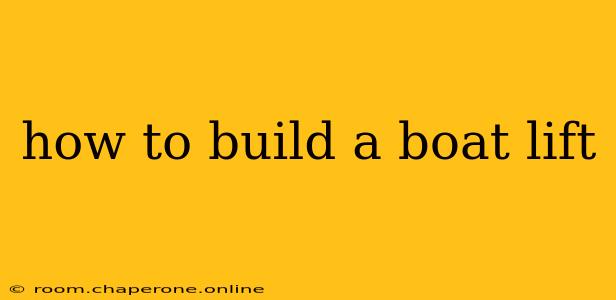Building your own boat lift can be a rewarding project, saving you significant costs compared to purchasing a pre-made lift. However, it's a complex undertaking requiring careful planning, precision, and a good understanding of engineering principles. This guide will walk you through the process, offering crucial considerations for a successful build. Remember, safety should always be your top priority throughout this project.
Planning Your Boat Lift Project: Crucial First Steps
Before diving into construction, meticulous planning is paramount. Several key factors need careful consideration:
1. Determine Your Boat Lift Type:
Several types of boat lifts exist, each with its own advantages and disadvantages:
- Floating Boat Lifts: These are simpler to build but require sufficient water depth and may not be suitable for all dock configurations.
- Hydraulic Boat Lifts: These offer greater lifting capacity but necessitate the purchase and installation of a hydraulic system, significantly increasing complexity and cost.
- Cable-Driven Boat Lifts: These are relatively simple, using a system of cables and pulleys for lifting. They are a good balance between cost and lifting capacity.
The best choice depends on factors like your boat's weight, budget, and available space.
2. Assess Your Budget and Resources:
Building a boat lift involves material costs (lumber, concrete, cables, hydraulic components, etc.), tools (welder, concrete mixer, etc.), and potentially professional assistance for certain tasks. Create a detailed budget encompassing all potential expenses. Accurately assess your available tools and skills; don't hesitate to seek assistance from experienced builders or professionals for tasks outside your comfort zone.
3. Obtain Necessary Permits:
Check with your local authorities regarding permits and regulations for building a boat lift. Requirements vary by location, and failure to obtain necessary permits can lead to penalties.
4. Site Preparation and Design:
Thoroughly survey your dock and surrounding area to determine the optimal location for your boat lift. Consider factors like water depth, accessibility, and the structural integrity of your dock. Create detailed drawings and specifications, including dimensions, material lists, and assembly instructions. This detailed plan will be invaluable during construction.
Building Your Boat Lift: A Step-by-Step Approach (Cable-Driven Example)
This section outlines the construction of a simple cable-driven boat lift. Remember, this is a simplified example; adapting this to your specific design and boat is crucial.
1. Constructing the Support Structure:
This usually involves a sturdy frame made of pressure-treated lumber or steel, depending on your design and budget. Ensure the frame is robust enough to support your boat's weight plus a significant safety factor.
2. Installing the Winch and Cable System:
A robust winch is essential for lifting your boat. Securely mount it to the support structure. The cable system should be designed with multiple pulleys to reduce the effort required for lifting. Use high-strength cables designed for the weight of your boat.
3. Building the Boat Cradle:
The cradle should securely support your boat's hull, preventing damage during lifting. Consider using foam padding to protect the hull.
4. Connecting the Cradle to the Cable System:
The cradle needs to be securely attached to the cable system, ensuring a smooth and controlled lifting process.
5. Concrete Foundation (If Necessary):
Depending on your design, a concrete foundation might be necessary for added stability and support. Ensure the foundation is properly poured and cured before attaching the support structure.
6. Testing and Adjustments:
Before using the boat lift, thoroughly test it with a weight similar to your boat. Make adjustments to the cable system and cradle as needed to ensure smooth and safe operation.
Safety Considerations:
- Always follow local safety regulations.
- Use appropriate safety gear, including gloves and eye protection.
- Regularly inspect the boat lift for wear and tear.
- Never exceed the lift's rated capacity.
- Ensure the lift is properly anchored to prevent movement.
Conclusion:
Building a boat lift is a significant project demanding careful planning and execution. While it offers cost savings and a sense of accomplishment, it’s important to acknowledge the complexities involved. Prioritize safety throughout the process, and don't hesitate to seek professional assistance when needed. A well-planned and executed boat lift project can provide years of reliable service. Remember to always consult with professionals for specific design and safety requirements tailored to your location and boat type.

